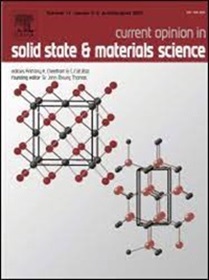Monolithic 3D integration as a pathway to energy-efficient computing and beyond: From materials and devices to architectures and chips
IF 13.4
2区 材料科学
Q1 MATERIALS SCIENCE, MULTIDISCIPLINARY
Current Opinion in Solid State & Materials Science
Pub Date : 2024-10-01
DOI:10.1016/j.cossms.2024.101199
引用次数: 0
Abstract
As emerging technologies like artificial intelligence (AI) and big data continue to evolve, the demand for high-performance computing (HPC) has been increasing, driving the development of computing chips towards greater energy efficiency and multifunctionality. Monolithic 3D integration (M3D) is poised to be a key enabling technology, by vertically stacking multiple functional layers made of backend-of-the-line (BEOL)-compatible devices on top of Si circuits and interconnecting them with high-density interlayer vias (ILVs). Currently, contenders for functional materials and devices in M3D include carbon nanotubes, two-dimensional (2D) materials, oxide semiconductors and a variety of emerging memories, such as resistive random-access memory (RRAM). This article first discusses the key properties and latest research developments of those materials and their device applications. As a representative example, we then review the recent progress on RRAM-based M3D architectures that integrate memory, computing, and other functional elements to facilitate computing-in-memory (CIM). Finally, we further discuss the opportunities and challenges of M3D as a promising pathway to energy-efficient computing.
单片三维集成是通往高能效计算及其他领域的途径:从材料和器件到架构和芯片
随着人工智能(AI)和大数据等新兴技术的不断发展,人们对高性能计算(HPC)的需求与日俱增,推动了计算芯片向更高能效和多功能方向发展。单片三维集成(M3D)有望成为一项关键的使能技术,即在硅电路上垂直堆叠多个由兼容后端(BEOL)器件构成的功能层,并通过高密度层间通孔(ILV)实现互连。目前,M3D 功能材料和器件的竞争者包括碳纳米管、二维 (2D) 材料、氧化物半导体和各种新兴存储器,如电阻式随机存取存储器 (RRAM)。本文首先讨论了这些材料的关键特性和最新研究进展及其设备应用。然后,作为一个具有代表性的例子,我们回顾了基于 RRAM 的 M3D 架构的最新进展,该架构集成了内存、计算和其他功能元素,从而促进了内存计算 (CIM)。最后,我们进一步讨论了 M3D 作为实现高能效计算的前景广阔的途径所面临的机遇和挑战。
本文章由计算机程序翻译,如有差异,请以英文原文为准。
求助全文
约1分钟内获得全文
求助全文
来源期刊

Current Opinion in Solid State & Materials Science
工程技术-材料科学:综合
CiteScore
21.10
自引率
3.60%
发文量
41
审稿时长
47 days
期刊介绍:
Title: Current Opinion in Solid State & Materials Science
Journal Overview:
Aims to provide a snapshot of the latest research and advances in materials science
Publishes six issues per year, each containing reviews covering exciting and developing areas of materials science
Each issue comprises 2-3 sections of reviews commissioned by international researchers who are experts in their fields
Provides materials scientists with the opportunity to stay informed about current developments in their own and related areas of research
Promotes cross-fertilization of ideas across an increasingly interdisciplinary field
 求助内容:
求助内容: 应助结果提醒方式:
应助结果提醒方式:


